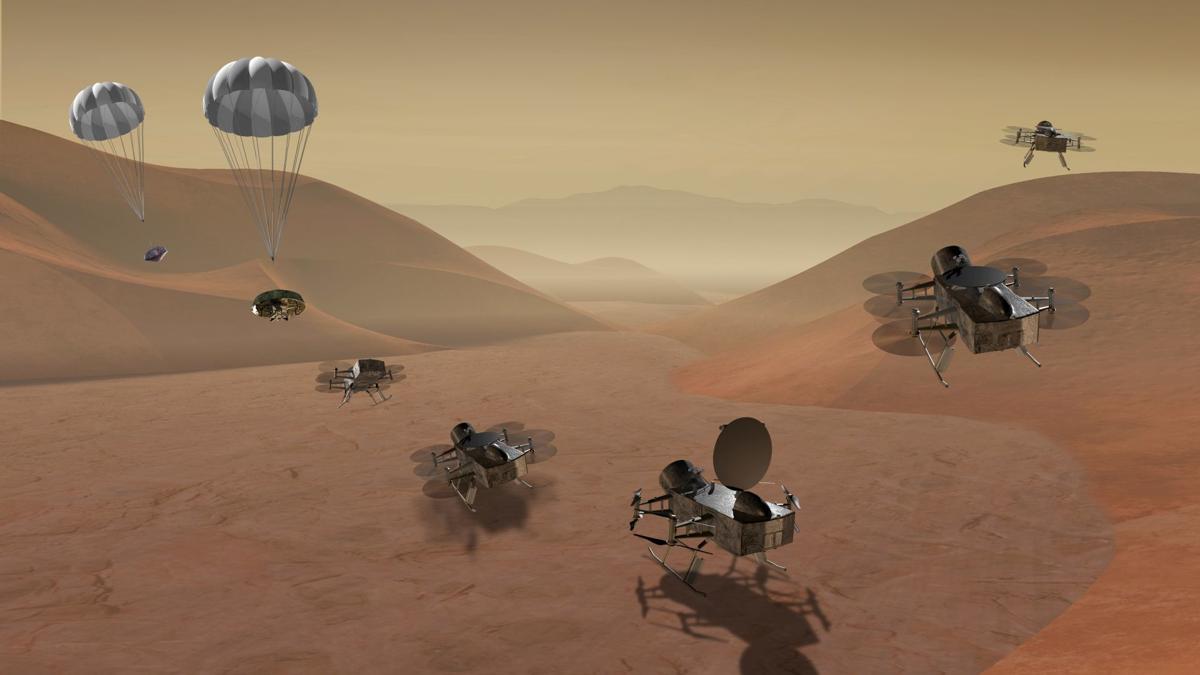Scientists at the Tucson-based Planetary Science Institute will assist NASA in its next big mission to explore the solar system.
As part of NASA’s New Frontiers program, the newly announced Dragonfly mission will send a spacecraft to the surface of Titan, Saturn’s largest moon. The drone-like lander will explore dozens of sites on the moon’s surface, sampling material along the way so that scientists can learn more about its composition, chemistry, atmosphere and potential habitability. Besides Earth, Titan is the only other world in the solar system with standing bodies on liquid on its surface.
Dragonfly is scheduled to launch in 2026, spending eight years in flight and traveling 840 million miles.
Once it arrives at Titan, the dual-quadcopter will make flights up to 5 miles around the moon once every Titan day, which is about 16 Earth days.
It will do this for about 2½ years and cover over 100 miles.
The spacecraft itself is capable of traveling up to 20 mph and flying as high as 2 miles above the surface.
According to Catherine Neish, senior scientist at PSI and co-investigator on the Dragonfly mission, Titan has a unique makeup, which makes it a perfect candidate for discovering signs of life.
“Titan, we think, has all the ingredients we need for life,” she said. “It has this atmosphere that’s rich in carbon molecules, and we know carbon is super important for life here on Earth. And it has a crust, so it has rocks on the surface made out of water ice, we think.”
Believed to be one of the most earth-like places in the solar system, Titan also has a thick organic atmosphere made of mostly nitrogen and some methane.
Scientists also believe that Titan is hiding an underground ocean of liquid about 35 to 50 miles below its icy surface.
As a co-investigator, Neish, along with fellow PSI senior scientist R. Aileen Yingst, will help analyze data, choose landing sites and try to make the mission as scientifically valuable as possible.
Neish will focus on Titan’s geology, including impact cratering, volcanism and surface chemistry, while Yingst, who is based in Brunswick, Maine, will focus on past and present geologic processes.
Neish, who is based in London, Ontario, Canada, began studying Titan during her Ph.D. program at the University of Arizona.
She said she was inspired by NASA’s Cassini mission, which explored the surface of Saturn for more than a decade, and collecting data about Titan in the process.
“I was just super excited about this new world that we hadn’t seen before and so I decided to focus my work on Titan,” said Neish.
Her Ph.D. focused on how scientists might be able to make prebiotic or biological molecules on the surface of Titan.
“We really predict that we will find really interesting prebiotic molecules on Titan, but we want to see how far that chemistry goes. You can only do lab experiments for so long,” said Neish. “So, with Dragonfly, we want to go there and sample the surface to see how far it’s gone toward the origin of life because that will tell us something about how life develops on other worlds.”
Elizabeth Turtle, the lead investigator on Dragonfly, worked at PSI from 2002-2006 and is now at the Johns Hopkins Applied Physics Laboratory, which will manage the mission for NASA.
Dragonfly is the fourth exploration mission selected as part of NASA’s New Frontiers program.





